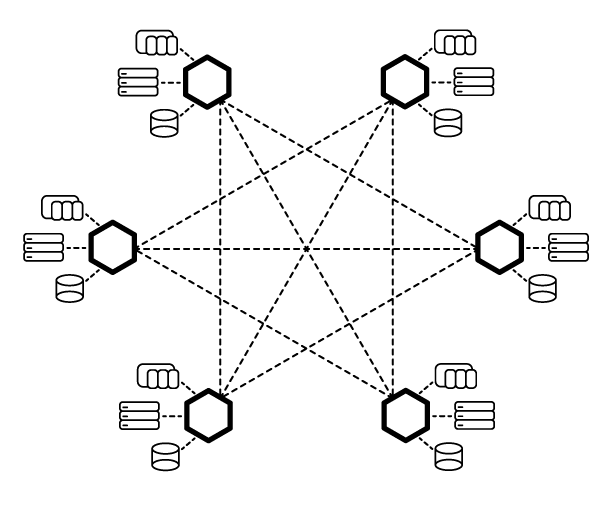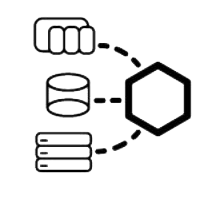EAS Distributed Network Architecture
EAS Universal Data Connectors can be deployed in any configuration to achieve the highest performance, reliability, and flexibility in you network environment. You can aggregate data and logic in the cloud, take advantage of an Edge Computing architecture or combine features to meet your needs.

Features of EAS Distributed Network Architecture
All Empowered Automation Software products have EAS DNA built into the core communications.
- Data is hosted right from the data source for best data accuracy.
- Lightweight protocol with compressed data packets.
- Secure transport utilizing encryption.
- Data resolution down to 100 nanoseconds.
- Data speed is extremely fast transferring multiple values in each packet.
- Easy setup and allows unlimited redirects to get to the data source.
No Data Loss On Network Failure
By hosting data directly from the data source there is no data loss on a network failure.
- All values are queued and delivered to each unique client on change.
- Delivery verification and watchdogs for both clients and servers.
- Data Logging and Alarm Logging with Store and Forward.
- Data Logging can push over 1,000,000 records per network call.
- Alarms are evaluated and processed at data source.
- Trend values are processed and cached at data source.
Product Features
The core of the EAS Platform, enabling data connectivity, server-to-server networking, and more

Log data in open format to MS SQL Server, Oracle, mySQL, PostgreSQL, InfluxDB, MongoDB, SQLite, MariaDB, Access, SQL Azure, Amazon Aurora, Amazon RDS, Amazon Redshift, Google Firebase, and CSV files
Log events to open databases, and send notifications via SMS, email, and voicemail

Read and write data to Allen Bradley, Siemens, and Modbus devices, Universal Drivers, OPC, OPC UA, databases, Excel, and read MTConnect.
Build custom Visualizations, User Interfaces, HMIs and Dashboards for Windows, web, as well as native iOS and Android devices
Develop custom automation apps for Windows, web, and mobile devices. Integrate with .NET and REST APIs. Build custom integrated device drivers.

Provides the most robust, scalable, and reliable distributed networking platform for IIoT solutions
EAS Distributed Network Architecture beats typical Cloud Architectures
When it comes to networking your critical IoT typical cloud architectures are simply not up to the task. Only Open Automation Software’s Distributed Network Architecture allows you to host your own live data with no data loss on network failure.
NETWORK FEATURES
- Accurate Live Data
- No Data Loss on Network Failure
- Small Compressed Packet Size
- Open TCP Transport WCF and/or REST
- High-Speed Throughput < 50 ms
- Verification of Delivery of Data Source to Destination
- Data Resolution of 100 Nanoseconds
- Encrypted Secure Data Packets
- Fastest Communication Possible No Database Required
- Unlimited Data Usage No Fees
EAS IoT DNA
Typical Cloud
A Complete Solution for All Networks
EAS has multiple network forwarding, redirect, and hosting solutions that can be used in any combination together to send and receive data through any corporate network securely, with or without the Internet.
Basic Networking with Static IP Address
Live Data Cloud Networking with Dynamic IP Address at Data Source
Network Forwarding for redirect path through any number of servers
Unidirectional Network Gateway for transferring through communication diodes
Improve Existing Cloud Services
EAS networking can enhance the reliability and accuracy of your existing cloud network with the support of the following and thousands more.
Amazon Web Services
MQTT
Windows Azure
- AWS IoT Gateway
REST API
.NET Data Connector
Basic Networking with Static IP

Client applications communicate directly to up to 10,000 remote services that have a fixed IP Address or registered domain name.
Live data is hosted directly on the Data Source Services, there is no data loss on network failure.
Live Data Cloud Networking with Dynamic IP
This free network feature turns any Windows laptop or server PC into a live data source with just a standard Internet connection. No VPN is required. Host live and historical data on your own local hardware.

Client applications communicate through one or more Live Data Cloud services that have a fixed IP Address or registered domain name to up to 10,000 remote services.
The data source services do not need to have a fixed IP Address, just be able to reach the Live Data Cloud Servers that do have fixed IP addresses.
Live data is hosted directly on the Data Source Services, there is no data loss on network failure.
The Live Data Cloud feature is free to use on any self-hosted Windows OS.
Network Forwarding
This free network feature provides an unlimited number of redirects through corporate networks to provide direct access from client to data source.

Client applications communicate through one or more Forwarding services that have a fixed IP Address or registered domain name to up to 10,000 remote services.
The data source services do not need to have a fixed IP Address, just be able to reach the final Live Data Cloud Servers that do have fixed IP addresses.
Live data is hosted directly on the Data Source Services, there is no data loss on network failure.
The Network Forwarding feature is free to use on any self-hosted Windows OS.
Unidirectional Network Gateway for Communication Diodes
The secure networking setup for critical data flows.

Client applications connect to one or more servers on the receiving side of the communication diode.
The data servers do not need a static IP address. They broadcast a selective list of local and remote tag variables or all local tag values at an adjustable rate to one or more remote servers that do have a fixed IP address.
- Each receiving server can receive data from multiple broadcasting servers providing a many to many network configuration.
This network feature will use more bandwidth than the other network features as it has to transfer all values at all times, but this can be reduced by selecting specific tag variables to broadcast.
This feature is typically by our nuclear power customers to transfer data one way to business applications, but recently adoptive by manufacturing companies and municipalities to eliminate the threat of a cyber attack.

